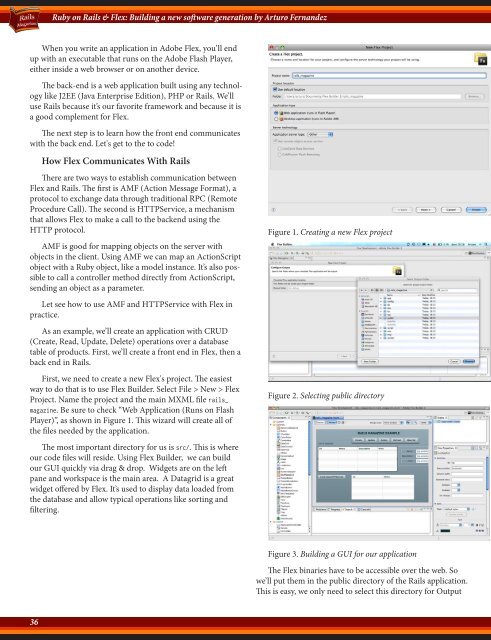Rails Magazine - Issue 3
Rails Magazine - Issue 3
Rails Magazine - Issue 3
Create successful ePaper yourself
Turn your PDF publications into a flip-book with our unique Google optimized e-Paper software.
36<br />
Ruby on <strong>Rails</strong> & Flex: Building a new software generation by Arturo Fernandez<br />
36<br />
When you write an application in Adobe Flex, you’ll end<br />
up with an executable that runs on the Adobe Flash Player,<br />
either inside a web browser or on another device.<br />
The back-end is a web application built using any technology<br />
like J2EE (Java Enterprise Edition), PHP or <strong>Rails</strong>. We’ll<br />
use <strong>Rails</strong> because it’s our favorite framework and because it is<br />
a good complement for Flex.<br />
The next step is to learn how the front end communicates<br />
with the back end. Let's get to the to code!<br />
How Flex Communicates With <strong>Rails</strong><br />
There are two ways to establish communication between<br />
Flex and <strong>Rails</strong>. The first is AMF (Action Message Format), a<br />
protocol to exchange data through traditional RPC (Remote<br />
Procedure Call). The second is HTTPService, a mechanism<br />
that allows Flex to make a call to the backend using the<br />
HTTP protocol.<br />
AMF is good for mapping objects on the server with<br />
objects in the client. Using AMF we can map an ActionScript<br />
object with a Ruby object, like a model instance. It’s also possible<br />
to call a controller method directly from ActionScript,<br />
sending an object as a parameter.<br />
Let see how to use AMF and HTTPService with Flex in<br />
practice.<br />
As an example, we’ll create an application with CRUD<br />
(Create, Read, Update, Delete) operations over a database<br />
table of products. First, we’ll create a front end in Flex, then a<br />
back end in <strong>Rails</strong>.<br />
First, we need to create a new Flex's project. The easiest<br />
way to do that is to use Flex Builder. Select File > New > Flex<br />
Project. Name the project and the main MXML file rails_<br />
magazine. Be sure to check “Web Application (Runs on Flash<br />
Player)”, as shown in Figure 1. This wizard will create all of<br />
the files needed by the application.<br />
The most important directory for us is src/. This is where<br />
our code files will reside. Using Flex Builder, we can build<br />
our GUI quickly via drag & drop. Widgets are on the left<br />
pane and workspace is the main area. A Datagrid is a great<br />
widget offered by Flex. It’s used to display data loaded from<br />
the database and allow typical operations like sorting and<br />
filtering.<br />
Figure 1. Creating a new Flex project<br />
Figure 2. Selecting public directory<br />
Figure 3. Building a GUI for our application<br />
The Flex binaries have to be accessible over the web. So<br />
we’ll put them in the public directory of the <strong>Rails</strong> application.<br />
This is easy, we only need to select this directory for Output


